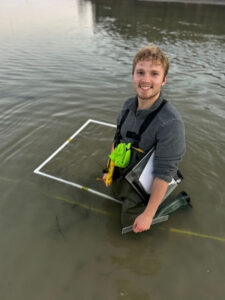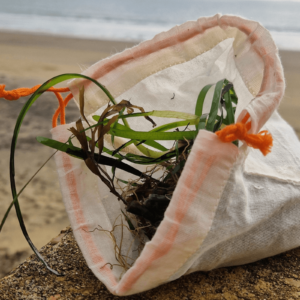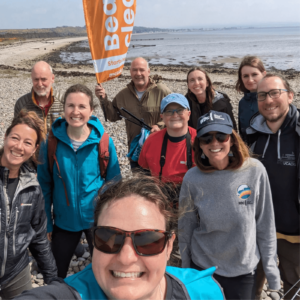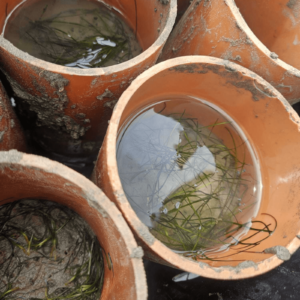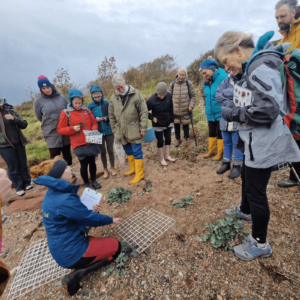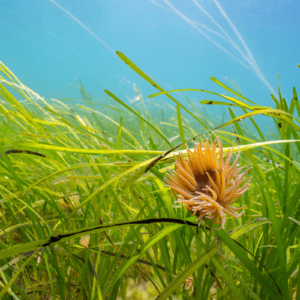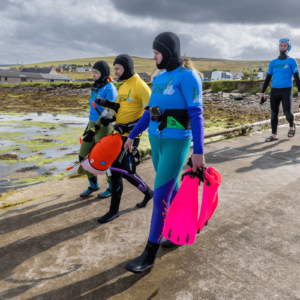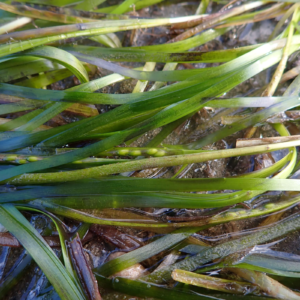Read our fieldwork notes from our summer seagrass seed collection: North Wales Seed Collection A brilliant start to our annual seed collections, with summer finally arriving right on time! The weather has been fantastic, with underwater visibility not too far off 10m, and not a drop of rain so far… Here’s hoping it holds out until next week! It’s been a very busy start, but here’s just a few of the highlights: Day 0.5 – Day 1 | Saturday 27th – Sunday 28thAfter arriving in good time on Saturday afternoon and launching Gwen with no troubles, the team spent Sunday morning moving all our equipment into Cabin Gryff and Gwen, before setting up the temporary seed storage tanks. We then went through a few rescue refreshers. The dive team set up the keep nets on the RNLI buoys, which will be home to all the seeds collected by both teams during the trip. The team practiced diver recovery drills, before finishing the day with a first seed collection dive The snorkel team went out seed collecting, but having missed the morning Low Tide, learnt the hard way that duck diving for seeds is rather tiring! Day 2 | Monday 29thThe snorkel team, led by Amel, started the day as they will throughout the trip, with seed tank water changes! They then had a far more successful seed collection snorkel, bagging plenty of seeds. Charles has also started his VR footage collection using the 360 camera, capturing some fantastic images of the meadow. Fingers crossed some fun species ‘take the bait’. Meanwhile, Manning has been sampling sites as part of his Masters project, with the help of Richard, who has been out flying the drone round the LLyn, taking advantage of the clear skys! The dive team completed three meadow health surveys, which will help us assess the current state of the Porthdinllaen meadow, and monitor any potential impact of our seed collections going forward. We were joined by Katie Dubois, a lecturer at Bangor University, who helped with our afternoon seed collection dives. The meadow is bursting with seeds, so we should be set for a good collection! Day 3 | Tuesday 30thThe snorkel team had their best collection yet today, and were in the water battling the cold for a good 4 hours! Another big haul of seeds! The dive team ticked off half the mechanisation surveys, which will help wrap up the mechanisation project. We then went seed collecting, whilst dropping down Charles’s VR camera to catch some footage. Day 4 | 31st JulyWe arrived early to set up our stand ready for our FIRST volunteers. We also welcomed our Ambassador Miranda Krestovnikoff. Day 5 | 1st AugustOne quick water change later and we’re back in the water! We started by taking the VR camera out to get a series of snorkeling shots through and coming out of the seagrass meadow before placing down for an hour-long shot. We then proceeded to pick seeds joined by Leanne and Miranda. Once again, a perfect dive, with pristine waters and life abundant. To end our day off we did a quick evening session with the VR camera. It was an amazing shoot with many fish species and a perfect way to end the day. Day 6 | 2nd AugustToday we rested. Day 7 | 3rd AugustAfter an excellent rest day we proceeded to begin our week of volunteer seed collections. We started the day by transporting volunteer divers off before getting everything prepared for the snorkel volunteers. The day went brilliantly, with all snorkelers/waders returning, smiling and with happy faces. We chatted, and met so many fantastic people! Day 8 | 4th AugustOnce again, Amel and Emma were up bright and early to transport volunteer divers before joining the rest of the day. We joined WWF for a Philanthropy Day, a day for all of our donors and backers. The day started with a quick meal before returning to set up all equipment and stand ready to take our donors for a quick snorkel. All came back with smiles and a successful day all around. The dive team been out every day for seed collections, seed collections, seed collections! Jake Davies and Neil Shone have joined throughout, and we had Dr Katie Dubois (Bangor University) with us again on Sunday! Day 9 | 5th AugustA windy and rainy storm has scarpered all snorkelling activities! We’ve all but finished the mechanisation trial surveys (there’s a few buoys missing so we may have to return and drop shot lines on the coordinates). The best news is there are still lots of seeds coming up after every dive! We’ve all but filled three keepnets (the total we managed last year), so hopefully we should be well on target for 1.5 million by the end of the trip! We’ll be out to install another keepnet tomorrow. Volunteers divers have also been joining since Saturday, with great feedback from all. Day 10 | 6th AugustToday was the first of our snorkel and wading volunteering sessions and it went really well! We were joined by 51 volunteers including WWF, Iwan Rheon, the Crown Estate, North Wales Wildlife Trust (with their Youth Forum and Interns) alongside lots of Project Seagrass volunteers! BBC joined us and interviewed Leanne and Rich! The dive team carried out two more dives (for me at least) with lots of seeds collected. We are into our fourth keepnet of seeds, which exceeds last year’s total already, and we’re hopeful the reproductive shoots are bearing more seeds than previous years too. Day 11 | 7th AugustCharles, Andrew, and volunteer Antje headed to Porthdinllaen this morning to capture more footage for the VR Project while Andrew and Corinne headed to Hafan y Mor to install a seagrass information sign. Another successful snorkel and wading volunteering session delivered in the afternoon/early evening. Over 30 volunteers joined us including representatives from the Crown Estate, WWF, and North Wales Wildlife Trust. BBC Radio Cymru joined to interview members of the
